The Moorabbin Co-operative Society
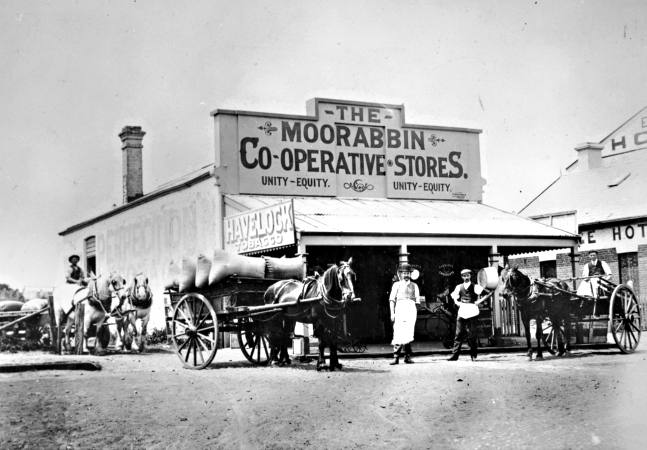
Moorabbin Co-operative Stores, Point Nepean Road, Cheltenham, c1910. Courtesy City of Moorabbin Historical Society.
Through the initiative of a few local residents, the Cheltenham Co-operative Store commenced trading late in 1896, registered under the name Moorabbin Co-operative Society, with sixteen shareholders and a share capital of £80. The registered office was Daphne Cottage, the home of Francis Thomas Le Page, on the corner of Wilson and Bernard streets, Cheltenham. The first chairman of the society was Robert Mills with J H Butler as secretary and F T Le Page as treasurer. E C Rippon was appointed the first manager. [1]
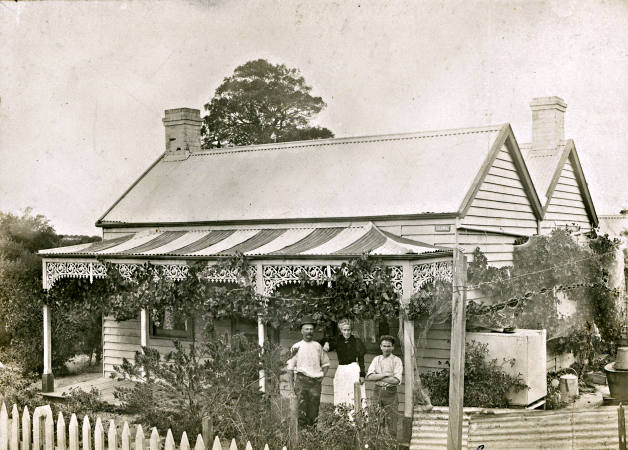
Daphne Cottage, Bernard Street, Cheltenham. Courtesy Len Le Page, Kingston Collection.
Each shareholder took up a minimum of five shares at £1 each. In return for this investment they received regular interest on shares as well as a rebate on purchases. The first store was opened in Cheltenham selling a range of groceries and farm implements on a site next to the Exchange Hotel. In its 92 year history the Society experienced times of great success and expansion, and at other times strife and confusion, until it closed its operation in 1988.
Wikipedia in its history of the co-operative movement indicates that the movement began in Europe in the nineteenth century and describes a co-operative as a business organization owned and operated by group of individuals for their mutual benefit. [2] Importantly, it was a jointly owned and a democratically controlled enterprise. Through its ability to purchase larger quantities of goods it was able to negotiate discounts from suppliers, the benefits of which were passed on to members.
At its first annual meeting of shareholders the president of the organization, Robert Mills, reported a satisfactory year with a good profit being achieved from a turnover of £3,300. As a result shareholders were paid a bonus of six pence in the pound on purchases. Non shareholders were paid half that amount. Total dividends paid amounted to £49/13/3; interest £6/9/9; depreciation provisions £7/19/8; with £10 being carried forward to the next financial year. [3] Edward C Rippon the manager was paid 3 ½ per cent of the total turnover. For the first five weeks he received £1.12.6 ($3.50) per week.
The new local newspaper, The Moorabbin News, regularly carried advertisements urging everyone to become a member of the Society pointing out that the entrance fee was one shilling and a payment of 3/3 per quarter on five shares of one pound each gave them full benefits of membership. [4] Advertisements for articles were also lodged with the newspaper showing : sugar 15s a bag, hay rakes 1s 6d, plow chains 4d per lb, reap hooks 1s 3d, scythe handles 3s 6d and Kuro egg preservative 3s a gallon, sufficient to preserve 50 dozen eggs. All this went together with the request to show the price list to friends. [5]
In 1901 business became difficult. The district market gardeners were achieving very low prices for their cabbages and turnips so the Moorabbin Co-operative Stores in Cheltenham sent railway wagons loaded with cabbages, turnips and carrots to Wycheproof where drought-stricken sheep farmers were attempting to keep their flocks alive with chaff costing £5 per ton. In contrast the vegetables were priced from thirteen to twenty five shillings. Wagon loads of vegetables landed in the Mallee brought half the price of chaff. The Argus reported that cabbages in the Victorian Market were selling at 4d to 5d a dozen while several loads weighing two tons were sold for 5 shillings a load in the country. [6] The railway department granted special conditions for freight so that it reached its destination as cheaply as possible.
It was not always smooth sailing for the Society. Business became very difficult and it reached a point in 1905 when consideration was given to winding-up the co-operative. The Moorabbin News reported in March that the manager, Edward C Rippon, had tendered his resignation but was asked to reconsider his decision and a sub committee was appointed to report as to the most economical way of disposing of the business. [7] In the following week’s newspaper the president of the Moorabbin Co-operative Stores, at that time, Cr Francis Thomas Le Page, issued a correction. He said Edward Rippon had been given one month’s notice of dismissal nearly a fortnight before the reported meeting, a dismissal that commenced on the first day of March. This notice had been given to him in writing and was quite formal in nature. [8] This report was in turn challenged by Edward Rippon in a letter to the editor of the newspaper suggesting what was written in the original Moorabbin News report was ‘true in fact, if not in substance’. [9] He went on to say that Mr Le Page acknowledged that he as manager had used every effort to cope with a difficult situation and that the deficit experienced over the past year was not attributable to the manager or management. A subsequent well-attended meeting of the co-operative members resolved to postpone the winding up of the business for twelve months and appointed C Judd to take on the role of manager. [10]
Business revived under Judd, so much so that in 1909 the committee was recommending to the Society members that plans and cost of a new brick building be obtained to expand their operation. Considerable discussion followed on the advisability of investing £500 in bricks and mortar. George Brownfield suggested that because the stores had been doing so well for three or four years was not a reason for any hurried action. He forecast a tough time ahead for the market gardening community and argued for a ‘go slow’ suggesting that the amount of money committed to the exercise be restricted to £200. The majority of members of the Society thought otherwise and empowered the committee to spend up to £500 on developments which included a new premises, up-to-date fittings and accommodation for the manager. [11]
Barrington and Dyson followed Judd as managers. Under Dyson in 1914 further renovations of the Point Nepean premises occurred to accommodate expanding trade. [12] With profit for the half year reaching £478/10/7, and an increased payment being made to shareholders, a resolution was passed instructing the committee to consider the advisability of purchasing more land. [13]
In 1911 and again in 1918 the Co-op’s premises on Point Nepean Road were burgled. On the first occasion thieves succeeded in getting £30. A side door was found open early one Saturday morning and a bag spread on the floor where cheques and papers were scattered around. A side window had been forced open after sawing through iron bars. A large fire proof safe was found open. The second instance also involved safebreakers but on this occasion they were active at the railway station, and the premises of W P Fairlam as well as the Co-op. At the Co-op explosives were used to blow the safe but it contained only books, so the perpetrators were foiled in their desire to gain money. Detectives from Russell Street Police Station were of the opinion that the robbers were amateurs who had earlier stolen a quantity of explosives from a tile maker in Oakleigh. [14]

Cheltenham Co-operative Stores, Cheltenham, image taken from Notice of Meeting. Courtesy: Len Le Page, Kingston Collection.
Under manager Harry Ray in 1922 a branch of the Co-op was opened at Mentone, at first in small rented premises, but with its ongoing success, in 1932, the Society purchased the freehold of the long established firm of J Abbott.& Son in the main shopping centre of Mentone. In the early 30s trade was depressed, reflecting the world wide impact of the stock market crisis in New York. Nevertheless, profits were still made. The Society had sales of over £26,000 and cleared a trading profit of almost £5,000 in one year. [15] At the election of directors for 1931 chairman, G Brownfield, commented that some local people were critical of the ‘old buffers’ in some local organisations and if members of the Society wanted young blood in the directorate and replaced him, he would not be offended although he would ‘feel it’. After all, he pointed out, he had been a founding director, more than thirty years earlier. The challenge was not accepted, George Brownfield retained his position.
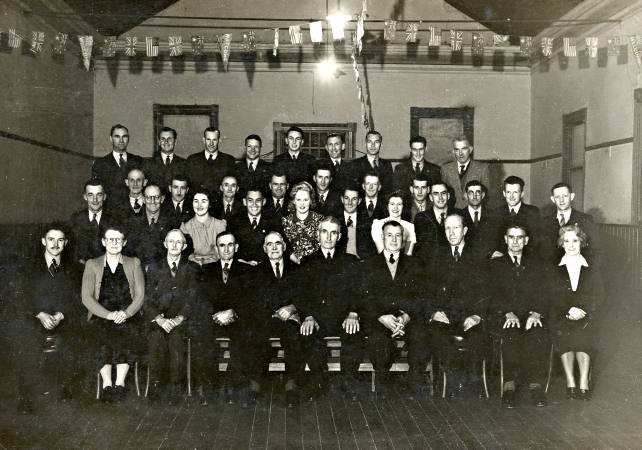
Directors and Staff of the Cheltenham and District Co-operative Society Ltd at time of 50th Anniversary, 1946. Courtesy Len Le Page, Kingston Collection.
Celebrating its sixtieth anniversary in 1955, the Society signed a contract for the erection of a modern store adjoining the old premises on Nepean Highway, Cheltenham. The new store on the corner of Hill Street and the highway designed by Egglestone, MacDonald & Secomb, and built by Colin Mason of Moorabbin, was opened in August 1956. It was built on piers because of the swampy condition of the soil due to seepage flowing down from a soak further up the hill. [16]
In the new building more attention was paid to increasing the range of services by making provision for a delicatessen, fruit and vegetables, medicines, kitchen hardware, paints, frozen food, bread and cakes, garden tools, electrical goods and general hardware; reflecting the advice of manager F G Benson. A modern butcher’s section provided prepacked meats and meat cut to order. Other features were the mechanical checkouts, wire shopping baskets, prices clearly marked and shelves being illuminated with fluorescent lighting strips. [17] It was the precursor by some years to the modern supermarket and initially was not readily accepted by local customers. Moreover, Fairbank’s grocery with their shop close by on Nepean Highway and Moran & Cato in Charman Road, provided stiff competition. [18]
Four years later the businesses at Mentone and the new store at Charman Road, Cheltenham were converted into modern self service stores. Two new stores employing the same principles were also opened at Clayton and Noble Park but they failed to prosper. A year after the conclusion of the Second World War land had been purchased in Moorabbin with the intention of creating a store when conditions became more favourable for building but this venture did not eventuate. [19]
In 1962 the rumour quickly spread throughout Cheltenham that the Co-op Stores in Nepean Highway were closing with the premises being leased to Griselda toy store. The rumour proved to be true. It was some years later, in 1986, that the property was auctioned and sold for $1,580.000. By then the land area involved was 48,860 square feet. Two blocks which formed part of the original Co-op site next to the Exchange Hotel had been sold previously; one to Motor Spares Limited on 21 December 1960 and the other to Harold Stanley and Adela Taylor furniture importers and retailers on 25 May 1977. [20]
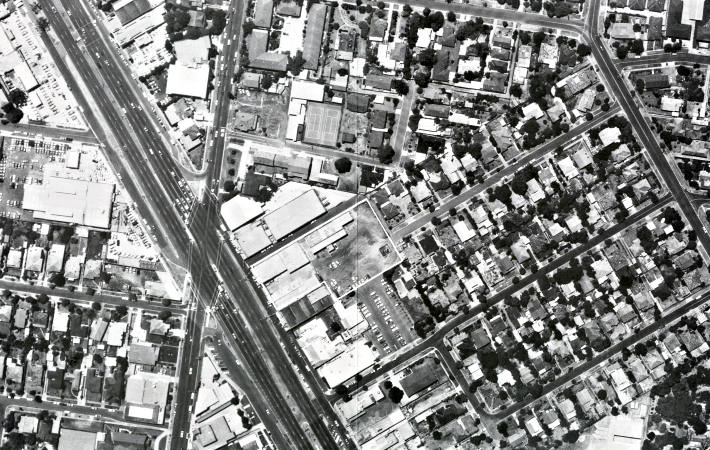
Aerial photograph of Cheltenham from auction brochure for sale of Cheltenham Co-operative Society land and buildings on Point Nepean Road, 1986. Courtesy Len Le Page, Kingston Collection.
With the sale of the Nepean Highway property the focus of the Society moved to the store in Charman Road as the Mentone business, originally established in 1922, had been sold in the early 1970s. The Charman Road store was built in the 1950s when the Co-op directors decided to create a store there because the shopping strip had become the major commercial centre of the town. At first the directors planned to purchase a vacant block of land and build but were unsuccessful when the land was sold at auction at a price they thought excessive.[£4 per foot] Instead when the adjacent building was placed on the market they purchased it and converted the billiard hall and two front shops into a modern store, later to be converted into a self service shop. November 1962 saw the business gain a liquor licence. By 1987 the principal income for the Society was derived from the operation of the Charman Road store as retail liquor outlet and from investment funds. [21]
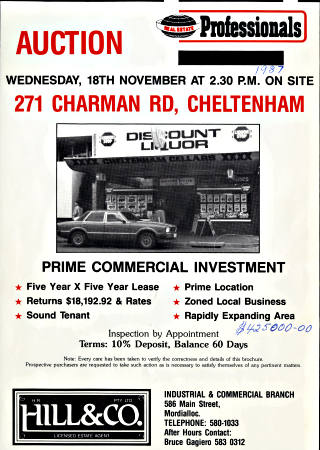
Auction brochure for 271 Charman Road, Cheltenham by Hill & Co, Mordialloc. Courtesy Len Le Page, Kingston Collection.
Myer Emporium Ltd opened a new regional shopping centre in 1968 on land purchased from the Roman Catholic Order, Hospitaller Brothers of God on Nepean Highway approximately six hundred metres north of where the Co-op Society first established itself. In addition, in 1985 Mr Walker, the Minister of Planning, gave approval for the rezoning of the site previously occupied by Lucas Industries, on the corner of Bay Road and Nepean Highway, for the creation of the Cheltenham Market. These developments placed increasing competitive pressure on the Co-op business in Charman Road. In addition, many of the shareholders saw the time was appropriate to recoup the money that they or their family originally paid for the shares. As a consequence the directors sold the Discount Liquor business in Charman Road at auction on 28 November 1987 for $425,000. [22] The following year on 14 April a special meeting in St Matthew’s Parish Hall was called to consider the voluntary winding up of the Society. Shareholders accepted the recommendation of the directors of the society which resulted in the distribution of its financial assets amongst them. Shareholders made a substantial capital gain when they received $48 for each share which originally cost $2, irrespective of when they were purchased; ninety two years before or two years. [23] Extensive efforts were made to locate all shareholders but where this was not possible the money was paid into consolidated revenue to the benefit of the government. Consequently, this was the end of an organisation that served the local community; supplying groceries, bread, gardening equipment firewood, hay and corn, fencing material, poultry food and hardware for ninety two years.
Footnotes
- The Rules of the Moorabbin Co-operative Society were signed by; Francis Thomas Le Page, George Musgrave, George Thomas Allnutt, Harry Stooke, John Taylor, Robert A Mills, George Follett.
- Wikipedia the free encyclopedia: History of the cooperative movement.
- The Argus 30 November 1897.
- Moorabbin News 7 April 1900.
- Moorabbin News 3 November 1900.
- The Argus 7 June 1901.
- Moorabbin News 18 March 1905.
- Moorabbin News 25 March 1905.
- Moorabbin News, 1 April 1905.
- Edward Rippon opened his own business in Charman Road, serving the public for twenty five years.
- Sandringham Southern Cross, 26 June 1909.
- Moorabbin News 3 October 1914.
- The Argus 25 June 1914.
- The Argus 11 June 1918.
- Moorabbin News 3 January 1931.
- Discussion with Len Le Page.
- Mordialloc News 9 August 1956.
- Discussion with Len Le Page.
- Annual Directors’ Report 17 September 1946.
- Information provided by Len Le Page, a company director at the time.
- Report to Shareholders, 1987.
- Information provided by Len Le Page, a company director.
- Communication Len Le Page.
